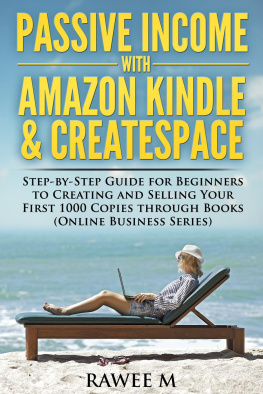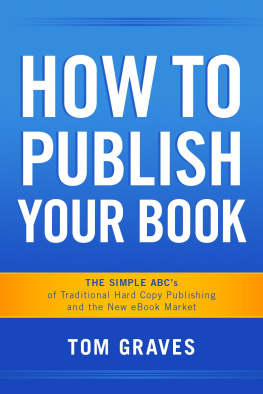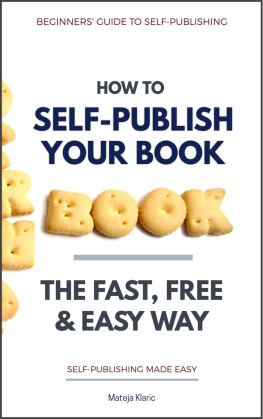Table of Contents
DIY Publishing
A STEP-BY-STEP GUIDE FOR PRINT AND EBOOK FORMATTING AND DISTRIBUTION
Maggie McVay Lynch
Windtree Press
Portland, Oregon
Copyright 2013 by Maggie McVay Lynch.
All rights reserved. No part of this publication may be reproduced, distributed or transmitted in any form or by any means, including photocopying, recording, or other electronic or mechanical methods, without the prior written permission of the publisher, except in the case of brief quotations embodied in critical reviews and certain other noncommercial uses permitted by copyright law. For permission requests, write to the publisher, addressed Attention: Permissions Coordinator, at the address or email below.
Windtree Press
4660 NE Belknap Court
Hillsboro, Oregon 97124
http://windtreepress.com
email: windtree@windtreepress.com
Cover Design by Christy Caughie at http://gildedheartdesign.com
Book Layout 2013 BookDesignTemplates.com
Permission granted from Dr. Julian Smart to use Jutoh screenshots within this guide. Jutoh is a product of Anthemion Software Ltd. http://jutoh.com
Ordering Information:
Quantity sales. Special discounts are available on quantity purchases by corporations, associations, booksellers, and others. For details, contact the Special Sales Department at the address above.
DIY Publishing / Maggie Lynch. 1st ed.
ISBN 978-1-19400642-6-0
Dedicated to Elaura Renie
You talked me into it, and here it is.
Thank you!
CHAPTER 1
Overview of DIY Publishing
Only in the last year has the combination of software programs and vendor sites converged to make the DIY publishing process significantly easier. With competing distributors vying to sell books online, the attention to helping the self-publishing author navigate the technology has become paramount. I now have a process that takes me approximately ten minutes per book to move from a Microsoft Word document to generating the file types required for both ebooks and printPDF, MOBI, and EPUBresulting in a nicely formatted product that competes with most NY traditionally published products. The focus of this book is to feature this methodone which produces a product that is not generic and has options for incorporating features unique to a specific book, genre, or series without adding significant formatting time.
Though self-publishing has been around since the advent of the printing press, in modern times it was the push of an e-readerthe Amazon Kindlethat spurred the current revolution. Amazons Kindle turned six years old in 2013. This has not only changed the face of electronic book consumption, but also provided the opportunity for anyone with basic computer skills to publish a book at little to no cost.
Like any rapidly evolving technology, the ebook marketplace is exploding with optionsoptions for reader devices as well as options for authors and publishers to create books that deliver stories in the way readers want them. Only one thing is certainchange.
Software developers, marketers, and a variety of service providers are springing into action to meet the needs of thousands of indie publishers and small presses. The new software options range from: interior and exterior templates, to ebook conversions for different devices, to tracking sales from all vendors. The good news is the programs are getting easier to use. For the parts of the process authors find too onerous, there is always someone to help for a fee.
In addition to the technical side of self-publishing, authors can elect to pay someone for any part of the publishing process: from editing to cover design, and from public relations to hiring a virtual assistant to post to social media for you.
In the new publishing marketplace, the rules change even faster than the software. What worked for marketing and book discovery a year ago, no longer works as well today. In 2009 and 2010, many writers who made their ebook FREE for some period of time found themselves on a bestseller list. In 2011 and 2012, it was the protracted 99 cent sale for a month to get enough downloads to hit a list. In 2013, that is no longer the case. Retailers changed their algorithms so that book rankings now reflect sales over a 30 day period for example, instead of focusing on short term velocity.
Pundits who wrote how to game the system were out of touch within a year as popular vendors changed their algorithms and made different decisions on the best way to feature the millions of books they have to sell, while generating the most profit. It is up to the self-published author to understand how to position her book effectively in every venue as quickly as possible, so she can move on to write the next book.
In the past, marketing dollars were put into a big splash designed to create velocitythe ability to sell tens of thousands of copies in a short period of time. If a book didnt take off within a few months, it was soon remaindered (sold at a discount) or returned to the publisher. Authors who didnt earn out their advance often found the rest of their series cancelled or they simply did not get a follow on contract to complete the series.
Discoverability today is more about the slower word-of-mouth that builds over months and even years. With the availability of digital books and print-on-demand books, publishers can now keep a book available for years without losing money. Its a new world with new rules. But, as always, it still takes a good book, hard work, commitment, and patience.
What this book contains
When I talk to other authors, one of the reasons they fear going DIY is the technical hurdle of formatting. The primary focus of this book is on the step-by-step instructions of how to get your completed manuscript professionally formatted for both print and ebook distribution, and then uploaded to sell at the various distribution sites (Amazon, Kobo, Barnes & Noble, Apple, Sony, Ingrams, Baker & Taylor, and others). Over the past three years, I have tried a number of methods to create a professionally formatted bookranging from hand-coding HTML, CSS, and XML to uploading a Microsoft Word document to various conversion programs. My goal was to find a method that produced a nice-looking product for print, and an ebook product that worked well in all platforms. Because each e-reader has unique specifications, this meant no error codes would stop the ebook from being uploaded to a distributor. I wanted the entire formatting process to take less than 30 minutes per book. Finally, I was not willing to spend more than $50 on software to help me do this. In other words, I wanted a process that was consistent, easy to implement, and inexpensive.
Even though I have a technical background, I dont want to spend a lot of time doing technical things. I want to spend the majority of my time writing the next book. I have a very busy annual schedule which includes four to six book releases, four to five public speaking engagements, several book signings, and time reserved for family and church activities. So, my final criterion was that the method had to be accessible to the average non-technology savvy writer.
The DIY Decision Process
First, the writer must determine how much of the DIY process she is willing and able to take on. For example, I am willing to do my own formatting because I now have it down to only 10 minutes per book. Once learned, the procedure requires little creativity and can be done consistently every time. It is fulfilling to know that I can format the book to my specifications and upload it to any distributor I wish to engage. Controlling that final package is like wrapping a special gift for a friend.








